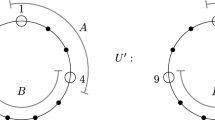Abstract
By means of a slight modification of the notion of GM-complexity introduced in [Casali, M.R., Topol. Its Appl., 144: 201–209, 2004], the present paper performs a graph-theoretical approach to the computation of (Matveev’s) complexity for closed orientable 3-manifolds. In particular, the existing crystallization catalogue \(\mathcal C^{28}\) available in [Lins, S., Knots and Everything 5, World Scientific, Singapore, 1995] is used to obtain upper bounds for the complexity of closed orientable 3-manifolds triangulated by at most 28 tetrahedra. The experimental results actually coincide with the exact values of complexity, for all but three elements. Moreover, in the case of at most 26 tetrahedra, the exact value of the complexity is shown to be always directly computable via crystallization theory.
Similar content being viewed by others
References
Amendola, G., Martelli, B.: Non-orientable 3-manifolds of small complexity. Topology Appl. 133, 157–178 (2003)
Burton, B.A.: Minimal triangulations and normal surfaces. PhD thesis, University of Melbourne, Australia, May (2003) (available from the Web page http://regina.sourceforge.net/data.html)
Burton, B.A.: Structures of small closed non-orientable 3-manifold triangulations. J. Knot Theory Ramifications (to appear), GT/0311113.
Bandieri, P., Casali, M.R., Gagliardi, C.: Representing manifolds by crystallization theory: foundations, improvements and related results. Atti Sem. Mat. Fis. Univ. Modena 49(Suppl.), 283–337 (2001)
Casali, M.R.: Classifying PL 5-manifolds by regular genus: the boundary case. Canad. J. Math. 49, 193–211 (1997)
Casali, M.R.: Classification of non-orientable 3-manifolds admitting decompositions into ≤ 26 coloured tetrahedra. Acta Appl. Math. 54, 75–97 (1999)
Casali, M.R.: Representing and recognizing torus bundles over \(\mathbb S^1\). Bol. Soc. Mat. Mexicana (special issue in honor of Fico), 10(3), 89–106 (2004)
Casali, M.R.: Computing Matveev’s complexity of non-orientable 3-manifolds via crystallization theory. Topology Appl. 144, 201–209 (2004)
Casali, M.R.: Estimating Matveev’s complexity via crystallization theory. Discrete Math. (to appear)
Casali, M.R., Cristofori, P.: Archives of closed 3-manifolds with low gem-complexity. Available from the Web page http://cdm.unimo.it/home/matematica/casali.mariarita/DukeIII.htm
Casali, M.R., Gagliardi, C.: Classifying PL 5-manifolds up to regular genus seven. Proc. Amer. Math. Soc. 120(1), 275–283 (1994)
Casali, M.R., Malagoli, L.: Handle-decompositions of PL 4-manifolds. Cahiers Topologie Géom. Différentielle Catég. 38, 141–160 (1997)
Ferri, M., Gagliardi, C.: The only genus zero n-manifold is \(\mathbb S^{\text {\it n}}\,\). Proc. Amer. Math. Soc. 85, 638–642 (1982)
Ferri, M., Gagliardi, C., Grasselli, L.: A graph-theoretical representation of PL-manifolds. A survey on crystallizations. Aequationes Math. 31, 121–141 (1986)
Gagliardi, C.: Extending the concept of genus to dimension n. Proc. Amer. Math. Soc. 81, 473–481 (1981)
Hempel, J.: 3-manifolds. Ann. of Math. Stud. 86, Princeton University Press, (1976)
Hilton, P.J., Wylie, S.: An introduction to algebraic topology – homology theory. Cambridge University Press, Cambridge UK (1960)
Lins, S.: Gems, computers and attractors for 3-manifolds, Knots and Everything 5, World Scientific, Singapore (1995)
Martelli, B., Petronio, C.: Three-manifolds having complexity at most 9. Experiment. Math. 10(2), 207–236 (2001)
Martelli, B., Petronio, C.: Census 7. Table of closed orientable irreducible 3-manifolds having complexity 7. Available from the Web page http://www.dm.unipi.it/pages/petronio/public_html/files/3D/c9/c9_census.html
Matveev, S.: Complexity theory of three-dimensional manifolds. Acta Appl. Math. 19, 101–130 (1990)
Matveev, S.: Algorithmic topology and classification of 3-manifolds. Algorithms Comput. Math. 9, Springer, Berlin Heidelberg New York (2003)
Matveev, S.: Recognition and tabulation of three-dimensional manifolds. Doklady RAS 400(1), 26–28 (2005). (Russian; English trans. in Doklady Mathematics, 71, 20–22 (2005))
Matveev, S.: Tabulation of 3-manifolds. Uspekhi Mat. Nauk. 60(4), 97–122 (2005) (Russian; English trans. in Russian Math. Surveys 60(4), 673–698(2005))
Ovckinnikov, M.A.: The table of 3-manifolds of complexity 7 (Preprint). Chelyabinsk State University, Russia (1997)
Scott, P.: The geometries of 3-manifolds. Bull. London Math. Soc. 15, 401–487 (1983)
White, A.T.: Graphs, groups and surfaces. North Holland, Amsterdam, The Netherlands (1973)
Author information
Authors and Affiliations
Corresponding author
Rights and permissions
About this article
Cite this article
Casali, M.R., Cristofori, P. Computing Matveev’s Complexity via Crystallization Theory: The Orientable Case. Acta Appl Math 92, 113–123 (2006). https://doi.org/10.1007/s10440-006-9065-y
Received:
Accepted:
Published:
Issue Date:
DOI: https://doi.org/10.1007/s10440-006-9065-y



